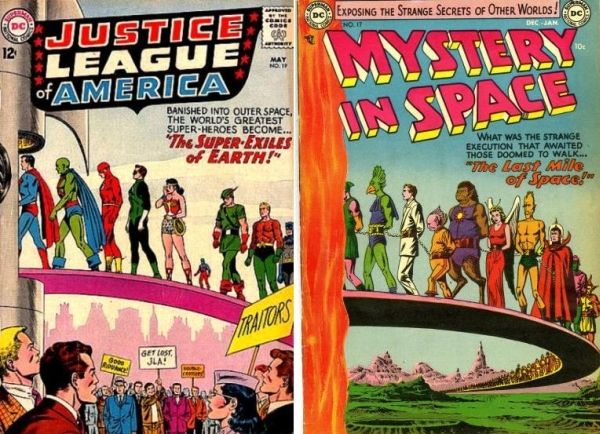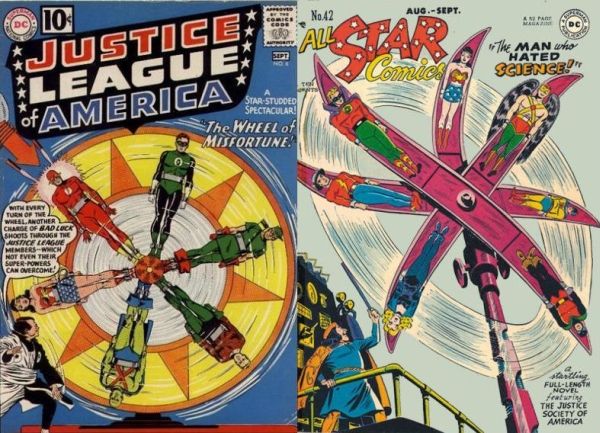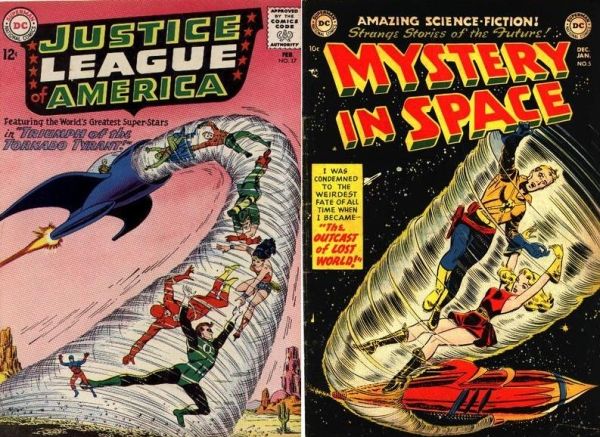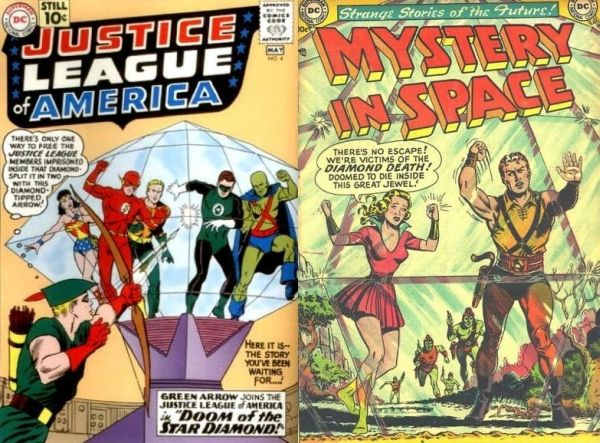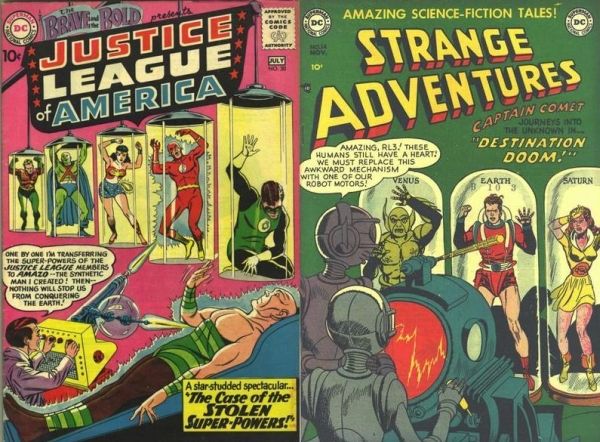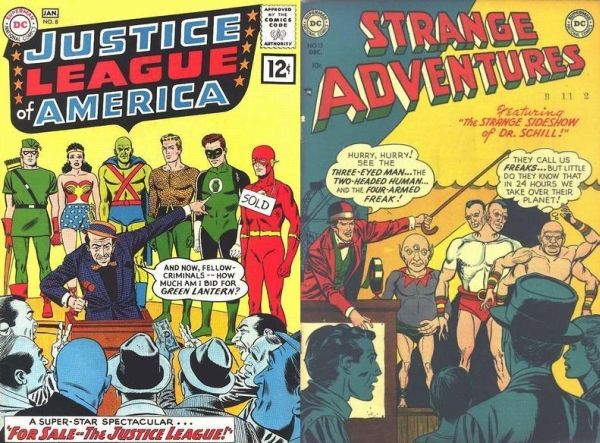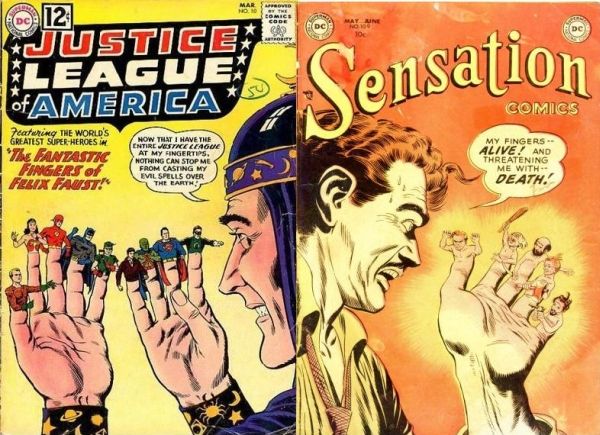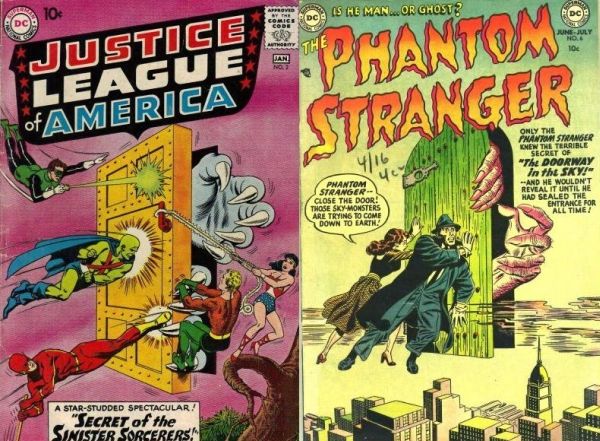You may be familiar with the early covers of the Justice League of America series. Many of those Murphy Anderson gems have become iconic. Did you know, however, that many of those cover designs have their roots elsewhere?
Some of these are well known swipes, while others merely borrow themes or concepts from other books. Either way, I find it fascinating that so many of these very famous covers have origins in the early parts of the Atom Age at DC. There are two key components to this recycling. First, with one exception, these examples come from a very specific time frame; between November, 1951 and February-March, 1954. Secondly, for the most part the original series were edited by Julius Schwartz and in many cases Murphy Anderson was involved with the original comic in one capacity or another.
The cover to Justice League of America #19 is perhaps the best known of example of a recycled cover design. Murphy Anderson channeled his own cover from Mystery in Space #17 (January, 1954). It was re-used once again for Strange Adventures #229 in 1971.
Justice League of America #22 features a terrific cover, and is the second part of the first JLA/JSA crossover. Once again, Anderson has takes the idea from an old cover, using Mystery in Space #18 (February-March, 1954) as his inspiration.
Justice League of America #6 is an example of Anderson borrowing a cover from a different artist, as he channels Irwin Hasen’s cover from All-Star Comics #42 (August-September, 1948). Is it a swipe or an homage? It’s also the earliest example of a cover recycled for the JLA that I found.
While not a direct swipe, Justice League of America #17 certainly borrows heavily from Mystery in Space #5 (January, 1952). On both covers, the heroes are caught in a tornado emanating from a spaceship.
An example of thematic recycling is the famous cover to Justice League of America #4, where Green Arrow joins. The idea of being trapped inside a giant diamond was previously used on the cover for Mystery in Space #9 (August-September, 1952).
Murphy Anderson’s cover to the Justice League’s third adventure in Brave and the Bold #30 is certainly one of the teams most iconic. I believe that Anderson got the idea from Gil Kane’s cover to Strange Adventures #14 (November, 1951). We’ve got characters trapped in glass cylinders and a laser beam. Although it’s a Kane cover, Anderson drew the Captain Comet story, so he was certainly familiar with the premise.
How about Justice League of America #8? It’s the famous, ‘JLA for Sale’ cover. I find it very similar to the ‘Alien Auction’ cover from Strange Adventures #15 (December, 1951), also by Gil Kane. We’ve got an auctioneer/barker, a line up of individuals on display and some shadowy onlookers in the foreground.
Another example of an idea being recycled rather than the entire image is the Felix Faust cover from Justice League of America #10. There are a few later examples of ‘finger puppet’ covers (see House of Mystery #214), but I can only think that this cover was ‘inspired’ by Sensation Comics #109 (May-June, 1952). I can’t ID the artist on the original cover, but Schwartz was editing the title at the time.
I had thought that I’d found all of the really good examples, when I started some ‘outside the box’ thinking. It occurred to me that the cover to Justice League of America #2 was very similar to Bob Brown’s cover to Phantom Stranger #5 (June-July, 1953). This discovery, which I stumbled upon just yesterday, led me to thinking that there are likely more out there somewhere.
I’m not trying to cast aspersions on the creators behind these early Justice League books, as most of the editorial staff DC recycled ideas and covers during this period. I just find it interesting that so many of these covers featured borrow ideas and images. If you know of any others, I’d love to see them.
For more comic book talk, stop by my blog: Seduction of the Indifferent

